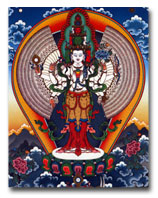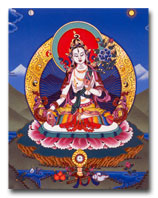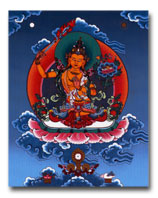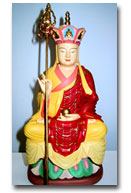
The
term Bodhisattva refers to someone on the path to Awakening.
The Mahayana has conceived them as having renounced the ultimate
state out of pure compassion towards all beings, and can therefore
refers to anyone en route. In non-Mahayana Buddhism,
it usually refers either to Maitreya, the Buddha of the Future,
or to the historical Buddha Gautama prior to his enlightenment
- either during the life in which he became enlightened or
in one of the innumerable lives before that in which he was
developing the requisite virtues for enlightenment, such as
generosity. The stories of these lives are called the Jatakas,
or 'birth stories', and they are a very frequent subject of
Buddhist art.
•
Avalokitesvara [Tibetan
style]
(Japanese,
Kannon, Kanzeon; Chinese, Kuan Yin, Guanshiyin;
Tibetan, Spyan-ras-gzigs; Vietnamese, Quan-am)
 Among
the Bodhisattvas, it is Avalokitesvara who has the largest
number of forms and is perhaps the most venerated and most
popular Buddhist deity. His sex, originally masculine, is
sometimes considered feminine in China and Japan, although
this discrimination is unsupported by any canonical text.
And was often considered in China and Japan as the 'mother
of the human race' and, in this respect, worshipped in the
form of a woman.
Among
the Bodhisattvas, it is Avalokitesvara who has the largest
number of forms and is perhaps the most venerated and most
popular Buddhist deity. His sex, originally masculine, is
sometimes considered feminine in China and Japan, although
this discrimination is unsupported by any canonical text.
And was often considered in China and Japan as the 'mother
of the human race' and, in this respect, worshipped in the
form of a woman.
Avalokitesvara
is known from very early in the development of the Mahayana
doctrines and, until Buddhism disappeared from India, enjoyed
great favour there. His cult passed from India to South-East
Asia and Java, where it met with great success, and also in
Nepal, Tibet (where he arrived with Buddhism and where King
Srong-btsan Sgam-po, 519-650, was considered to be his incarnation),
and in China, from where he went on to Korea and Japan. All
these countries imagined him in different forms according
to their own temperaments and spirituality.
•
The Taras [Tibetan
style]
(Japanese, Tarani Bosatsu; Chinese, Tuoluo;
Tibetan, Sgrol-ma)
 It
was not until the adoption of the Yogachara system, taught
by Asanga in the fourth century AD, that the feminine principle
began to be venerated in Mahayana Buddhism. Around the sixth
century, the goddess Tara was considered as a Sakti of Avalokitesvara
(sometimes as his wife). The Chinese pilgrim Xuanzang (seventh
century) claimed to have seen many statues of this deity in
northern India. However, she was not accepted by followers
of the Theravada, and her image is rarely to be found in Sri
Lanka or in South-East Asia (except perhaps in Java, where
a temple was dedicated to her in 779).
It
was not until the adoption of the Yogachara system, taught
by Asanga in the fourth century AD, that the feminine principle
began to be venerated in Mahayana Buddhism. Around the sixth
century, the goddess Tara was considered as a Sakti of Avalokitesvara
(sometimes as his wife). The Chinese pilgrim Xuanzang (seventh
century) claimed to have seen many statues of this deity in
northern India. However, she was not accepted by followers
of the Theravada, and her image is rarely to be found in Sri
Lanka or in South-East Asia (except perhaps in Java, where
a temple was dedicated to her in 779).
Many
legends have sprung up around this goddess. According to one
of them she was born in a beam of blue light emanating from
one of the eyes of Avalokitesvara; another has her born from
a lotus, floating in a tear on his face. It was believed in
Tibet in the seventh century that Tara was reincarnated in
every virtuous and pious woman: thus two of the wives of King
Srong-btsan Sgam-po, Wencheng, who was Chinese, and a Nepalese
daughter of Amsuvarman, came to be considered as incarnations
of Tara. To differentiate between the two wives, the Tibetans
created two distinctive Taras, white for the Chinese, with
a full-blown lotus as her emblem, and green for the Nepalese,
whose emblem is the blue (half-open) lotus. Each is believed
to have been born from an eye of Avalokitesvara (open and
half-closed). Hence they came to be considered as symbols
of the day (full-blown lotus, eye open) and the night (half-open
lotus, eye half-closed). But this couple soon multiplied,
and 21 Taras are mentioned.
In
China, this goddess was practically unknown, and was not at
all common. In Japan, she was given the rank of Bodhisattva
(Tarani Bosatsu), and she combines both aspects (white and
green) of the Tibetan Tara. She is practically only found
on mandalas or temple banners. She holds a pomegranate (symbol
of prosperity) and a lotus. She is pale green.
•
Manjusri [Tibetan
style]
(Japanese, Monju Bosatsu; Chinese, Wenshu; Tibetan,
Jam-dpal)
 Manjusri
is a disciple and, with Samantabhadra, an acolyte of Sakyamuni
Buddha in the groups of images called Shaka Sanzon
in Japan, 'the three venerables of Sakyamuni'. 'He whose beauty
is charming', the Bodhisattva 'of marvellous virtue and gentle
majesty',' represents wisdom, intelligence and willpower.'
His adoration confines divine wisdom, mastery of the Dharma,
an infallible memory, mental perfection, eloquence. This Bodhisattva,
known in India by the doctrines of the Theravada which identified
him with the king of Gandharva Pancasikha, was originally
known from many texts of the Mahayana. Although some texts
such as the Lotus Sutra assign him a universe in the east
called Vimala (Japanese Yuima).
Manjusri
is a disciple and, with Samantabhadra, an acolyte of Sakyamuni
Buddha in the groups of images called Shaka Sanzon
in Japan, 'the three venerables of Sakyamuni'. 'He whose beauty
is charming', the Bodhisattva 'of marvellous virtue and gentle
majesty',' represents wisdom, intelligence and willpower.'
His adoration confines divine wisdom, mastery of the Dharma,
an infallible memory, mental perfection, eloquence. This Bodhisattva,
known in India by the doctrines of the Theravada which identified
him with the king of Gandharva Pancasikha, was originally
known from many texts of the Mahayana. Although some texts
such as the Lotus Sutra assign him a universe in the east
called Vimala (Japanese Yuima).
Manjusri
was the initiator and master of the Buddhas of past ages and
will be that of the future Buddha, Maitreya. Manjusri is the
father and the mother
of the Bodhisattvas, and he is their spiritual friend. The
Buddha himself describes Manjusri and praises him in the Manjusri-parinirvina-sutra.
This Bodhisattva was consequently very often represented,
in India and Tibet, in China and Japan, as well as Nepal,
which tradition claims he founded on coming from China. His
images appear only late in Central Asia and on a few Chinese
stele, associated with Vimalakirti (Japanese Yuima Koji)
in the sixth century.
His
cult and images were introduced into Japan by Chinese monks
who, during a voyage to Wutaishan, learned that Manjusri was
reincarnated in the person of the Japanese monk Gyoki and
went to Nara in 736. One of these monks, Bodhisena (Japanese
Bodaisenna), succeeded Gyoki as director of the Buddhist
community of the Todai-ji (Nara) in 751 or 752. In turn, another
monk named Ennin travelled to China to Mount Wutai in the
year 840, during a journey that lasted nine years from 838
to 847, and brought back scriptures and images of this Bodhisattva.
•
Ksitigarbha [Chinese
style]
(Japanese, Jizo Bosatsu; Chinese, Dizang; Tibetan,
Sai-snying-po)
 The
name of this Bodhisattva means 'He who encompasses the earth'.
According to the monk Eshin (Genshin, 942-1017), he is also
the master of the six worlds of desire and of the six destinies
of rebirth. When considered in particular as a Bodhisattva
who consoles the beings in hell, he is identical to Yamaraja
(Japanese Enma-o), the king of the Buddhist hells (Naraka,
Japanese Jigoku). In India, Ksitigarbha, although known
very early to the Mahayana sects (since the fourth century),
does not appear to have enjoyed popular favour, and none of
his representations can be found, either there or in South-East
Asia. In China, on the contrary, he was fairly popular since
the fifth century, after the translation of the Sutra of the
Ten Cakras which lists his qualities.
The
name of this Bodhisattva means 'He who encompasses the earth'.
According to the monk Eshin (Genshin, 942-1017), he is also
the master of the six worlds of desire and of the six destinies
of rebirth. When considered in particular as a Bodhisattva
who consoles the beings in hell, he is identical to Yamaraja
(Japanese Enma-o), the king of the Buddhist hells (Naraka,
Japanese Jigoku). In India, Ksitigarbha, although known
very early to the Mahayana sects (since the fourth century),
does not appear to have enjoyed popular favour, and none of
his representations can be found, either there or in South-East
Asia. In China, on the contrary, he was fairly popular since
the fifth century, after the translation of the Sutra of the
Ten Cakras which lists his qualities.
Ksitigarbha,
moved by compassion, is said - like all Bodhisattvas - to
have made the wish to renounce the status of Buddha until
the advent of Maitreya, in order to help the beings of the
destinies of rebirth. In hell, his mission is to lighten the
burdens caused by previous evil actions, to secure from the
judges of hell an alleviation of the fate of the condemned,
and to console them. Thus, in the popular mind, Ksitigarbha
has become the Bodhisattva of hells par excellence.
His
cult remains immensely popular in Japan, where it spread from
the ninth century in the Tendai and Shingon sects. A popular
custom made him the confessor to whom faults committed during
the year were revealed, in the so-called 'confession of Jizo
ceremony'.